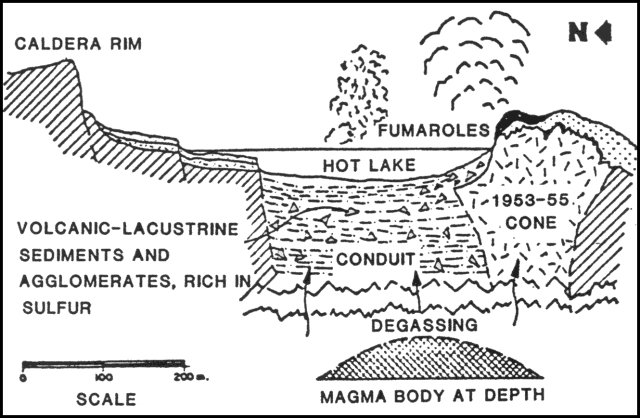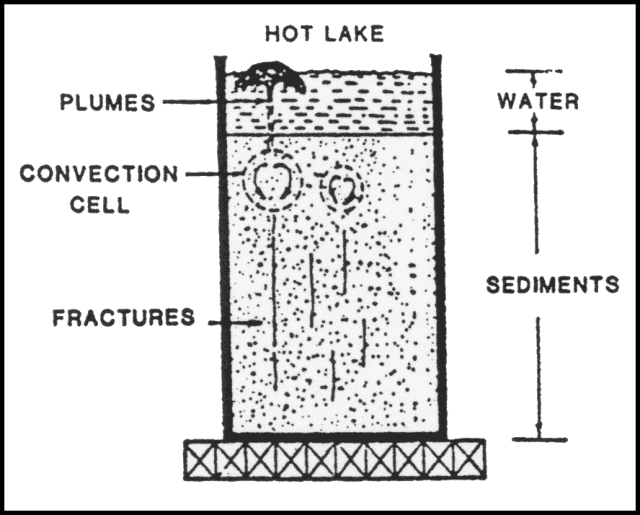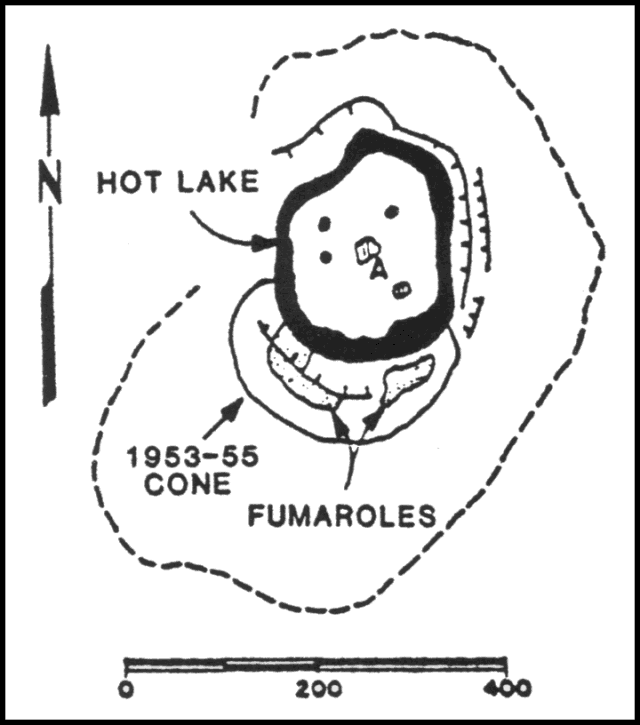Report on Poas (Costa Rica) — September 1988
Scientific Event Alert Network Bulletin, vol. 13, no. 9 (September 1988)
Managing Editor: Lindsay McClelland.
Poas (Costa Rica) Phreatic activity from crater lake
Please cite this report as:
Global Volcanism Program, 1988. Report on Poas (Costa Rica) (McClelland, L., ed.). Scientific Event Alert Network Bulletin, 13:9. Smithsonian Institution. https://doi.org/10.5479/si.GVP.SEAN198809-345040
Poas
Costa Rica
10.2°N, 84.233°W; summit elev. 2697 m
All times are local (unless otherwise noted)
Activity in the hot crater lake has remained vigorous since the onset of geyser-type phreatic explosions in June 1987. The postulated mechanism of activity is shown schematically in figures 4 and 5. During the first half of August 1988, plumes containing mud were ejected at intervals of 3 minutes, reaching 30 m above the lake surface. Activity occurred from three sites in the lake, but remained strongest at the central vent (figure 6). The explosions were accompanied by strong noise and emission of gas that was generally blown W by the wind. Geyser-type activity was almost continuous during the second half of August and the first week of September, with black mud plumes rising 5-10 m. During the rest of the month, plumes rose as much as 25 m. Heavy rainfall caused small changes in lake level during September. A rockfall occurred in mid-September on the NE edge of the lake, facilitated by concentric fractures. The rockfall scar had a maximum diameter of 30 m, was 15 m high, and 25 m wide.
Vapor ejected by the phreatic explosions caused acid rain within the crater, and irritated mucous membranes of people at the overlook. Water in Lake Botos, SE of the crater, has acidified slightly. The lake supplies water to the visitor center at Volcán Poás National Park, where pH of piped water was 4.5-4.8. Fumaroles on the remnants of the 1953-55 [dome] showed high concentrations of H2S and water vapor, moderate amounts of CO2 and H2, and little Cl2 (data from a Drager gas detector). The temperature on the [dome] was about 500°C. Seismic records from Poás volcano station (VPS) have not shown significant changes in the past 6 months. Tens of B-type earthquakes were recorded daily, while A-type events were scarce, confirming the shallow character of the activity.
Geological Summary. The broad vegetated edifice of Poás, one of the most active volcanoes of Costa Rica, contains three craters along a N-S line. The frequently visited multi-hued summit crater lakes of the basaltic-to-dacitic volcano are easily accessible by vehicle from the nearby capital city of San José. A N-S-trending fissure cutting the complex stratovolcano extends to the lower N flank, where it has produced the Congo stratovolcano and several lake-filled maars. The southernmost of the two summit crater lakes, Botos, last erupted about 7,500 years ago. The more prominent geothermally heated northern lake, Laguna Caliente, is one of the world's most acidic natural lakes, with a pH of near zero. It has been the site of frequent phreatic and phreatomagmatic eruptions since an eruption was reported in 1828. Eruptions often include geyser-like ejections of crater-lake water.
Information Contacts: G. Soto, UCR; Seccion Sismologia e Ing. Sismica, ICE; Rodrigo Saenz and E. Fernández, OVSICORI-UNA.




